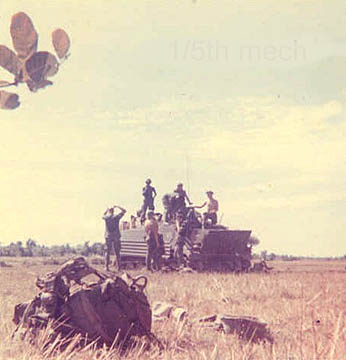
APC's are interesting vehicles. Back in Advanced Infantry Training
we learned that these stubby boxes were designed to carry infantrymen into battle and
protect them from small arms fire, up to and including the light machine gun. The
vehicle is propelled by two tracks, extending the length of the vehicle. The tracks
are made of lightweight composite material to keep the weight down and provide added
durability. The outside edges of the tracks are flush with the sides of the box, and
so on the inside these indentations provide seats for about four men on a side, with room
for one more towards the front - it is an ideal squad-sized machine. There is also
room for the vehicle's crew: two seats in front for driver and commander, and a standing
area for a gunner. The rear wall contains a large door, which swings down to become
a ramp. There is a weapon-mount ring on the front top, which carries the machine's
only weapon, a .50 caliber machine gun. The front end is shaped like a wedge, coming
forward from the bottom plate halfway to the top, and then reversing and angling back to
the top plate. This "bow" allows the vehicle to act like a boat when
crossing streams. To improve aquatic operations, a plywood sheet is attached halfway
up the front so that when opened up it continues the bottom plane another three feet
forward.
The technical details of the APC make it sound like an impressive fighting machine and
utility vehicle. But these had been made for another war, and another job. In
Vietnam we found they had certain drawbacks. The easiest way to stop a track was to
plant a land mine in the ground. The blast would go right through the aluminum floor
(that's right, aluminum - to keep the weight down) and it usually succeeded in killing the
occupants. And in a tropical environment like Vietnam, the inside was like a
furnace. So because of the heat, and the risk of land mines, we rode on top exposed
to all the world, and especially the enemy. But at least on top it was cool!
And we could see where we were going. To reduce the threat of injury to the crew, a
layer of sandbags usually carpeted the driver's area, and the floor of the passenger
compartment was usually covered with a couple of layers of C rations (they would stop
anything! And there was no need to worry about running out of food, either).
The front splash shield doubled as a carrying rack. A roll of chain link fence
used to protect the vehicle at night against rocket-propelled grenades was usually stored
here along with the steel posts that held it upright. But you had to be careful -
the constant vibration caused the posts to slip to one side until sometimes they were
hanging dangerously far out. On one interesting run down a paved Vietnamese highway,
we were going about thirty miles per hour, and the poles on the track in front of us were
hanging out about two feet. They were the same height as the side view mirror on a
truck. Advancing towards us in the oncoming lane, at about our speed, was a convoy
of deuce and a half trucks. From behind we could see what was coming. The
first truck rolled past, and with a crash its mirror was ripped from the mount, the glass
splinters exploding into the air in a burst of light. Seconds later the next truck
suffered the same fate, and the next. None of the drivers saw what was happening,
and the track operator probably never heard the sound over the roar and clatter of his
treads. It all happened so fast that before anyone had time to think nearly twenty
trucks had lost their driver’s side mirror.
Riding a track cross-country was a bit like riding an elephant. We rolled gently
along over the flat land, and when we came to a rice dike we climbed it. The front
of the vehicle would rise into the air and everyone held on tight. Then, reaching
the top, the box teetered precariously for a second, and then plopped forward to the other
side with a bounce. I enjoyed riding tracks. I liked to sit up front on top of
the chain link fence, with my back against the rear-sloping front wall, my feet hanging
forward, propped up against the plywood splash shield. When we started to drop
forward the sensation was like a roller-coaster starting down that first long drop.
But once you got used to the idea that there was a bottom, somewhere, it was fun.
You just had to learn to "ride" the animal. Many of the guys didn't want
to sit up front, exposed like that, but I never worried about it. We were all
exposed, no matter where we were.

APC - The Armored Personel Carrier: Tales Of A War Far Away
Copyright © 1995 Kirk S. Ramsey
Top photo Copyright © 1995 George Aimone
Last modified:
May 30, 2022
